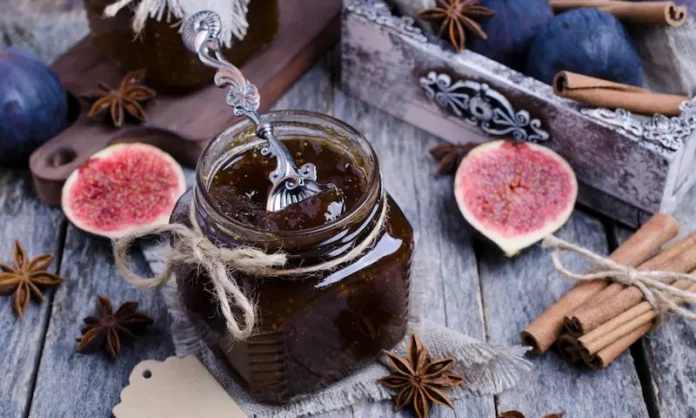Figs are a fruit that grows in the Mediterranean climate. They are rich in vitamins, minerals, antioxidants, and fiber, which protect our bodies from various diseases and improve our quality of life. While figs can be consumed either fresh or dried. One of the most delightful ways to savor their sweetness and aroma is by transforming them into jam. In this article, you can learn how to make traditional sugar-free fig jam, which is simple, delicious, and healthy.
Fig Jam as a Remedy
Fig jam is not only a tasty treat, but also a very beneficial addition to your diet. It is rich in antioxidants, fiber, and vitamins such as A, K, and B6. Providing support for heart health, strengthening immunity, and improving digestion. Its natural sugars provide energy, and its nutrients contribute to maintaining the body’s balance, transforming it into more than just a sweet treat.
For centuries, people have relied on traditional Grandmother’s sugar-free fig jam as the best natural remedy for cough. Especially in children. Our grandmothers always prepared and stored it for cold winter days to be ready for the upcoming colds. Also, this jam has proven to be an excellent natural remedy for bronchitis. If you suffer from any type of bronchitis, it is enough to take one spoonful of this jam on an empty stomach in the morning. The relief of symptoms is noticed after seven days of consumption.
Fig Jam Recipe
Creating this sugar-free fig jam takes a bit more time compared to standard fig preserves. Given its esteemed status as a prized product, dedicating time during the fig season to craft it ensures year-round enjoyment. When made and stored correctly in the pantry, it boasts an indefinite shelf life without an expiration date.
What do you need for preparation?
If you have decided to make fig jam, choose only ripe figs when picking them. Figs that are cracked and those that are not ripe enough can only spoil the original taste of this jam. Since there are several types of figs in our region, you may wonder which figs are best to use for making jam. Although they are different in appearance, shape, and color, the content is almost the same.
To make this fig jam without sugar, you will need about 30 kg of figs. It is important to mention that if you do not have enough to pick on the same day, you can pick them for several days. Store them in the freezer until you collect enough. When you have collected enough, you can start making fig jam.
How to Make Fig Jam Without Sugar
First of all, you need to wash and clean the figs well, then remove the stems and chop the figs into several pieces. Put the figs in a pot in which you will cook the jam, and mash them well with a masher to get a puree. Then add enough water to cover the figs and the magic can begin.
Making Grandmother’s fig jam demands complete attention; the initial cooking phase spans between 3 to 4 hours. Cooking over low heat is crucial to avoid burning, preserving the traditional taste of the jam. Periodic stirring is necessary, along with collecting the foam that consistently forms on the surface.
Draining is the most difficult part of the preparation
The hardest part of preparing this jam is squeezing. After the figs are well cooked, they need to be strained to remove the larger pieces of figs. For this process, you can use a sieve or a colander, gauze, and a masher. When the figs cool down, first mash them through a sieve or a colander and then strain them through a cotton gauze to get a clear juice.
There is another way that can reduce the time needed for mashing and squeezing. The traditional recipe for grandmother’s fig jam describes this phase as follows. Place a pot under a tree, and hook a clean jute bag over it, into which you will pour the boiled figs. After some time, the entire liquid content will drain into the pot, while the large pieces of figs will remain in the bag.
Once we have only fig juice, we begin the second phase of cooking, nearly completing our fig jam. It requires simmering over low heat until it thickens considerably, a process known as boiling that can take up to 5 hours.
How and where to store fig jam?
Once the jam is finished, take it off the heat and allow it to cool for about 20 minutes to half an hour. Your fig jam is now ready. For storage in the pantry, choose smaller jars of about 250ml, heat them in the oven, and pour the hot jam into them. Do not close them until the jam cools completely!
This jam, once prepared, doesn’t have a limited shelf life and doesn’t require refrigeration for storage. It can stand at room temperature and will not spoil. It is important to mention that the amount of jam obtained with the amount of figs in this recipe is 1:10. That is, from 30 kg of figs, you get about 3 kg of jam. If you liked this article, you can read more healthy recipes here.
